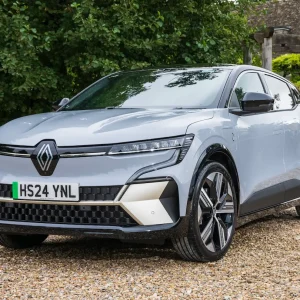When the DS 7 first arrived in 2018 it was a significant model, as the first new car from DS since it became an independent brand from Citroen. Now, it’s lost the former ‘Crossback’ tag from its name, and received a mid-life facelift. A medium SUV, it shares underpinnings with Stellantis group cousins such as the Peugeot 3008 and Vauxhall Grandland – though given DS’s premium brand positioning it has more upmarket aspirations than those models. Design elements of the facelift include sharper front-end styling, with slimmer headlights – featuring LED pixel technology – and daytime running lights.
Slightly unusually, there is no pure petrol engine option with the DS 7. Instead, you have a choice of a 130hp diesel, or 225hp, 296hp, or 355hp petrol plug-in hybrids. We sampled the middle PHEV, which offers impressive shove for a family SUV, with a useful slug of performance when we needed to overtake a cyclist on a country road, for instance. However, the 1.6-litre petrol engine can sound a little uncouth under acceleration. A new, larger 14.2kWh battery allows an increased range of up to 42 miles between charges, meaning the BIK tax rate for company car drivers is reduced to 8%.
The DS 7’s chassis is well up to coping with the power, with four-wheel drive offering an element of extra traction, and responsive steering even adds a slight sense of sportiness, which we found a bit surprising but not unwelcome. Ride quality we would generally describe as good, but not great – there can be an element of pitching about on undulating roads, possibly due to the effects of the heavy hybrid battery.
With our Opera-spec test car – one down from the top of the range – we found a very stylish and, to our eyes, attractive interior, particularly with cream-coloured trim highlighting some interesting contouring, and helping the analogue clock in the centre of the dashboard to stand out. A 12in infotainment touchscreen – redesigned with the facelift – is impressively large, clear and responsive, and well-integrated into the dash, rather than looking as if it was just plonked on top as many do these days. It also offers impressively clear images from the rear-view/360-degree camera system. A 12.3in driver display – now with updated graphics – also provides a useful range of information, integrating sat-nav instructions well.
Rear seat passengers benefit from their own climate controls and USB ports, and reasonable legroom. With the Opera grade’s standard sunroof, taller adults might be a bit squeezed for headroom, although this can be mitigated since the back seats recline electrically. The 555-litre boot is a good size, and unlike with some plug-in hybrids isn’t compromised by the battery compared with the diesel DS 7.
When we reviewed the DS 3, we noted that as a premium electric small SUV it didn’t really have any direct rivals. This is not the case with the DS 7 as a larger plug-in hybrid – and comparison doesn’t flatter it. Not only is the equivalent (in fact slightly more powerful) BMW X1 £6,000 cheaper to buy, it also offers significantly stronger expected residual values, with the DS 7 receiving a poor 32.9% rating from our data provider Kee Resources. This means that over a three-year/60,000-mile cycle, the DS is expected to cost nearly a whopping 22p-per-mile more to run than the X1 – and in fact even the larger equivalent BMW X3 comes out 6p ahead. Therefore, while the stylish DS does offer some good points, from a hard-nosed financial point of view it’s difficult to recommend.
DS 7 Opera E-Tense 4×4 300
P11D: £56,485
Residual value: 32.9%
Depreciation: £37,904
Fuel: £7,049
Service, maintenance and repair: £2,374
Cost per mile: 78.87p
Fuel consumption: 41.5mpg
CO2 (BIK %): 27g/km (8%)
BIK 20/40% a month: £75/£151
Luggage capacity: 555 litres
Engine size/power: 1,598cc/200hp with 110hp and 113hp electric motors





